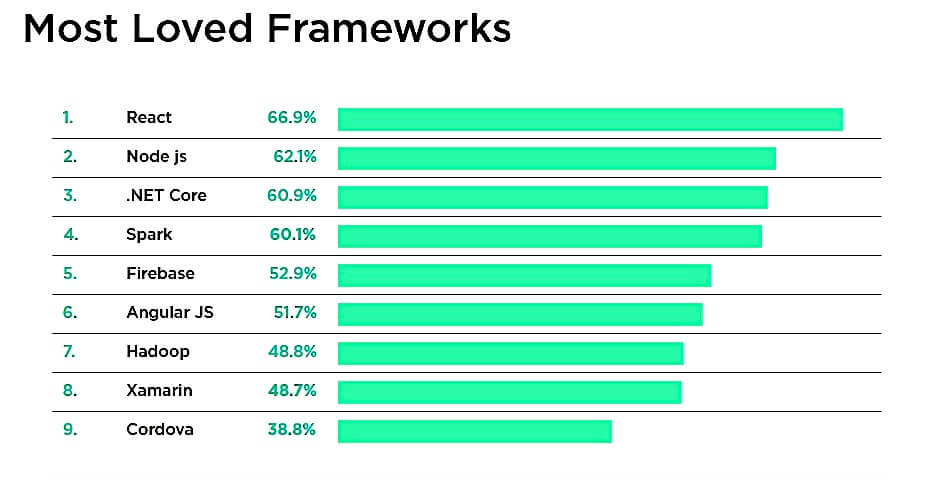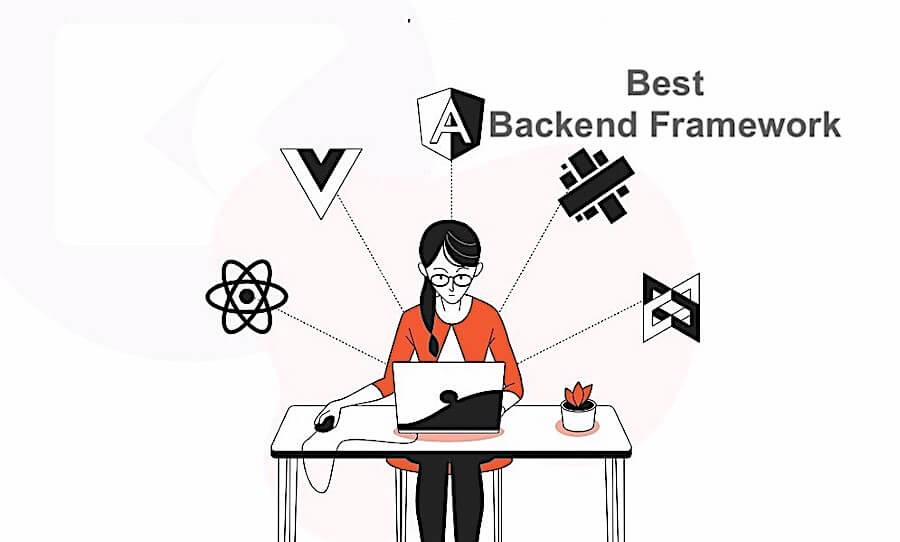Mobile and web applications are something that every smartphone user comes across multiple times a day. Applications are effective methods of flourishing business, no matter their nature. It is the duty of the developer and the client to ensure that the best backend web framework is used in the process of app development.
Discovering the most suitable backend framework for web application development can prove to be a tougher task than actually coding it. Nevertheless, don’t fret as this article will inform you about the top 10 trending backend frameworks in current times. In case of any uncertainties, seek advice from a proficient software development company.
Contents
Introduction To JavaScript Framework
A JavaScript framework is a collection of pre-written JavaScript code, libraries, and tools that developers can use to build web applications more efficiently and effectively. These frameworks provide a structured and organized approach to web development, simplifying complex tasks, enforcing best practices, and reducing development time.
Frameworks offer reusable components, pre-defined functions, and standardized coding patterns that developers can utilize to develop specific features or functionalities in their applications. They often come with built-in support for common tasks, such as handling user input, managing state, manipulating the DOM (Document Object Model), and handling AJAX requests.
The most common application of the backend JavaScript framework is to create mobile and web applications or basic/advanced websites. The ease of access is one of the topmost benefits associated with using these advanced frameworks.
Read more;- Top 21 Front-End Technologies Trends & Tools
The frameworks are gaining popularity as they boast a wide range of tools and libraries, and eliminate the efforts required to develop an app from scratch. A user can easily search for the pre-structured codes for various features and add them with ease. Using JavaScript frameworks is not only cost-efficient but also saves a lot of time.
Nearly all devices today use popular JavaScript frameworks, including Windows, Linux, macOS, Android, iOS, and smart TVs. As of 2022, 98% of the 1.8 billion websites globally employ JavaScript as a client-side language, highlighting its growing popularity.
Advantages Of Fastest Backend Frameworks
There are many benefits associated with the backend frameworks that contribute to its rising popularity. Let us uncover them one by one.
The foremost advantage of using a backend framework is that it saves a lot of time that otherwise could have been wasted in the absence of a framework. The time and energy that is saved can be utilized to fulfill various other aspects.
Another important benefit to mention is that it allows the user to conveniently import pre-structured codes from the library and integrate them with your website’s requirements.
The frameworks are effective tools that are used to camouflage the new codes with the existing website code. Hence, it suggested using the JavaScript frameworks for web app development instead of investing in new research and development.
Top 10 Backend Framework 2023 for Your Web Application
Application development is not an easy process, involving a lot of complex tasks. Such complex requirements demand modern tools to support mobile and web app development.
There are numerous frameworks that support web app development.

This section features the list of best backend frameworks available for application development in the year 2023.
Laravel Framework
Laravel Framework was introduced in the year 2011. It boasts a model-view-controller structure with a user-friendly interface. The framework is loaded with advanced tools and packages, varied libraries, and outstanding API support that enriches the web development experience.
The command-line interface or CLI known as the Artisan console is designed to accomplish complex and repetitive tasks. This reduces the workload on the developer, providing the opportunity to focus on more critical aspects of web development.
The framework has a great line-up of frontend templates. The Laravel framework’s Blade, unlike other PHP template engines, supports plain PHP codes.
The list of features and benefits makes it an ideal framework, both for beginners as well as experts. Laravel’s community support and detailed documentation further enrich the journey of web development.
Flask Framework
Flask Framework was released in the year 2010. It is based on the convergence of the Werkzeug library and the Jinja templating engine. It is a powerful framework that is derived from the concept of Python web application framework.
Unlike the other Python frameworks, Flask is quite popular for its lightweight structure that is simple to use and does not limit the user to select from specific tools and libraries.
The combination of Unicode-based support and adequate documentation facilities makes it a developer favorite amongst many backend web development frameworks available in the market. Flas can be bundled up for the development of basic website apps, IoT apps, and other types of scalable apps.
Django
Django was launched in the year 2005. It is a highly capable model-view template framework that promotes high-quality and rapid backend web app development. The minimalist coding structure makes it easy to work with, even for beginners.
Django shares some points of similarity and dissimilarity with its competitor, the Flask. Like Flask, it is also powered by the popular Python. However, Django targets complex web app development projects making it an ideal alternative to Flask which targets simple web apps. The great extent of flexibility that it offers promotes customization.
Moreover, it is easy to components for additional security like user authentication, and cross-site request forgery. Considering Django for developing complex and high-security platforms can be a good option.
Read more Comparision of:- Python vs Go
Spring Boot
It is the second model-view-controller framework in the list. Spring Boot made its way into the market in 2014. It makes the development process easy by eliminating many complex configurations that are otherwise involved in the web app creation.
Spring Boot supports third-party libraries for better scalability and boosting development speed. It is one of the most popular frameworks used for the development process. The foremost reason behind it is the fact that it uses Java as its coding language.
Developing a web application using Spring Boot can be a bit challenging for beginners however with the help of extensive documentation and a dedicated community, the development process can become a blissful experience for an enriched web app.
Express.js
Launched in the year 2010, Express.js is one of the lightest and fastest backend frameworks that allows the developer to integrate advanced features on the robust Node.js platform.
Node.js is a popular open-source server environment that is supported by various platforms. Express.js is highly benefited due to the already popular platform.
Ruby on Rails
Launched in the year 2004, Ruby on Rails is also known as Rails and is the third model-view-controller framework in this list. It boasts a component structure with elements being CSS, HTML, JavaScript, and the Ruby programming language for creating powerful and dynamic web applications. It provides hassle-free database table creation and migration combined with view scaffolding for a seamless web development experience.
The principle of convention over configuration works flawlessly to provide suggestions on web app development as soon as you get started with the process. It reduces the requirement of writing complex codes while stepping towards accomplishing the goals.
A strong community and plenty of online resources that are available for the purpose of web development make it an ideal framework, even for starters. Easy compilation and testing further elevate the development experience. There are numerous third-party plugins available for users working with Ruby on Rails which makes it an optimal choice for creating feature-rich web applications.
Meteor
Meteor made its way into the market in 2012. The framework is compiled with Node.js. The platform is free to use, and the open-source structure makes it easily customizable to create feature-rich web applications. It is extensively used by developers for the development of powerful mobile as well as web applications.
The full-stacked platform demands JavaScript for fulfilling backend and front-end development processes. With the help of Cordova, developers can target both iOS and Android platforms simultaneously.
Meteor is easy to learn and makes it an optimal choice for beginners. The minimalist coding approach and the requirement of basic JS knowledge make the entire development process effortless. Meteor is a complete package to create and deploy advanced web applications for businesses and contribute to their online presence.
Koa
Koa is an advanced framework that is supported by the expert team of Express.js. It has created hype in the market for being the new-gen tool for creating web applications. Koa is derived from the ECMAScript 6 specifications that make it stand apart from the rest of the Node.js frameworks.
Koa is developed to simplify the development of complex web apps and makes the whole process efficient. The platform is free from any middleware making it a lightweight framework.
An interesting fact about Koa is that its codebase contains all the essential elemental processes that are common to almost all the HTTP servers. Integrating elements from many modules that are available online is suggested by the experts for enhanced development experience.
NestJS
If developing an efficient backend application that is highly scalable as your next business move, considering NestJS can also be a good option. The framework was launched in the year 2017, making it the latest platform featured in this list.
Express.js serves as the foundation for NestJS; however, Fastify can also be used after minor configuration. It adds versatility to the platform.
NestJS is the final product obtained after observing and absorbing the good elements from a wide range of web app frameworks that are available in the market.
The web applications developed using NestJS are not only easy to maintain but also support testing and are highly scalable. The multiple modules available for the purpose can be readily merged with other advanced technologies for a stable product.
>>> VueJS React vs Angular <<<
AngularJS
AngularJS is a popular top backend framework that was launched in the year 2016. Considered the model-view-whatever framework, the framework has gained a tremendous reputation for creating ideal web applications for various enterprises.
The quick code production is supported by convenient testing capabilities of any part of the app coupled with effective data binding. AngularJS is highly preferred in developing single-page applications.
Explore more about;- Top 25 Angular 15 Interview Questions And Answers
The modern version of Angular boasts a long list of features that make it capable of developing web and mobile applications. Inter-component communication makes the application scalable even after its deployment.
Read more: – Pytorch vs Tensorflow Framework
Final words
The top 10 best javascript backend frameworks mentioned in the article are the most preferred choice of developers for developing feature-rich mobile and web applications. However, knowing about these frameworks is not enough for development as there is definitely more to it.
Experienced software development company & developers, that can be a one-stop solution for meeting all your digital needs. Utilizes the best js backend framework to carry the development process for a robust mobile and web application.
I produce technical information such as instructions to help users get to grips with all kinds of technology. The material I write is designed to allow their audience to use a particular tech or understand a word of upcoming technology.

